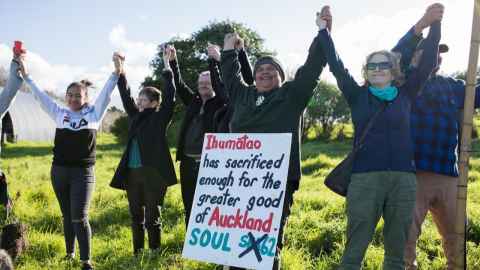The cost of our nation’s cultural heritage too high?
19 November 2018
Opinion: An Environment Court decision has paved the way for the destruction of the special cultural heritage landscape at Ihumaatao, near Māngere, exposing flaws in New Zealand’s heritage protection mechanisms.

Known as Special Housing Area 62, via pro-developer legislation passed under urgency in 2014, foreign-owned Fletcher Building Limited purchased the 32-hectare block in question in 2016. Fletcher bought the land from the descendants of the settler farming family who were granted ownership after its confiscation from mana whenua in 1863.
Since 2015, the mana whenua-led, community-supported campaign SOUL – Save Our Unique Landscape – has fought to protect Ihumaatao for future generations. SOUL appealed the decision of Heritage New Zealand Pouhere Taonga (HNZPT) to grant Fletcher authority to modify or destroy Māori and other archaeological sites on the land.
Fletcher’s application to HNZPT was rejected twice and returned without consideration because of inadequate consultation with mana whenua. Fletcher advised HNZPT that it would seek a judicial review if its third application was unsuccessful. The authority was granted in September 2017.
Established in 2014, HNZPT has a duty to ensure the “identification, protection, preservation, and conservation of ... historical and cultural heritage”. However, to March 2017, it granted almost 97 percent of applications (877 of 907) for developments affecting Māori archaeological sites.
HNZPT claims pre-application discussions can result in protective measures, but the Ihumaatao decision suggests the HNZPT Act 2014 almost exclusively favours private property rights and developer interests over protecting the values and benefits of our oldest cultural heritage places.
This Court decision shows the policy aspects of the Act have no statutory teeth, effectively ensuring the outcome we now have. The Court acknowledged the narrow scope of its evaluation; it focused on individual archaeological remains (such as middens) but excluded any assessment of the significant cultural heritage landscape values. It also recognised mana whenua have been adversely affected for a long time.
Inadequate consultation with mana whenua remains a major concern. Fletcher argues that it has satisfied the Act’s consultation requirements and that mana whenua support the development.
But mana whenua have staunchly fought development on all fronts for years. They worked to have Manukau City Council buy the land and make it part of the Ōtuataua Stonefields Historic Reserve as a mechanism to protect the authentic contiguous cultural heritage landscape it currently is. They fought alongside Auckland Council in the Environment Court in 2012, trying to stop the rezoning of the land to ‘future urban’.
Fletcher say they are working most closely with one iwi, but other iwi and hapū have strong connections to the area. Taking the route of mitigation does not mean that mana whenua support the development. It means, yet again, mana whenua were put in an impossible situation.
Negotiating the tensions of fighting on all fronts has affected some mana whenua relationships, but there will always be differences in perspectives and strategies when battling legal and political processes. This week the Court recognised the present situation is not what tangata whenua wanted.
SOUL was founded by six mana whenua cousins determined to take a stand in honour of the tūpuna, doing everything possible to protect the land for future generations – so they would have a place to come home to. SOUL went to the United Nations three times in two years, receiving strong support from the UN Committee for the Elimination of Racial Discrimination. Consultation, it stressed, does not imply consent.
No one at Ihumaatao wants a high-priced housing development on this wāhi tūpuna, wedged between one of oldest continuously occupied papakāinga in our nation and the boundary of the Ōtuataua Stonefields Historic Reserve, New Zealand’s Stonehenge. The development will overwhelm the surrounding environment; sounding a death-knell to its beauty and serenity, and eroding its rarity and completeness.
The Ihumaatao heritage landscape is currently on the United Nations International Council on Monuments and Sites (ICOMOS) at-risk register. New Zealand risks a reputation of failing to protect critical reminders of our precolonial legacies, including this rare, ancient beautiful place and its stories.
SOUL has called on the Government to intervene; to buy the land or mandate a process that ensures proper consultation and allows diverse minds to engage in blue-sky thinking on the best possible future for Ihumaatao. An open-minded, innovative, generous approach could create possibilities for new, exciting, world-class, mana whenua-led educational, research, visitor, eco-tourism and other opportunities.
Fuelled by audacious hope, SOUL has unremittingly pursued a kaupapa of respect aimed at protecting this unique cultural heritage landscape for future generations. SOUL welcomes up to 300 visitors to the land each week, leading guided tours for numerous schools and other groups.
Concern for the whenua and people power has sustained resistance over years and will give SOUL supporters the courage to stand together to face down the bulldozers, if it comes to that.

Dr Frances Hancock recently graduated with a doctorate, from the University of Auckland’s School of Māori and Indigenous Education.
Pania Newton, a graduate of the Auckland Law School, is a SOUL co-founder and spokesperson.
Nicola Short advises SOUL on heritage matters and teaches a masters level course in heritage conservation. She is the former Heritage Manager for Auckland Council and an ICOMOS member.
This article reflects the opinion of the author and not the views of the University of Auckland.
Used with permission from Newsroom The cost of our nation’s cultural heritage too high? published on 19 November 2018.